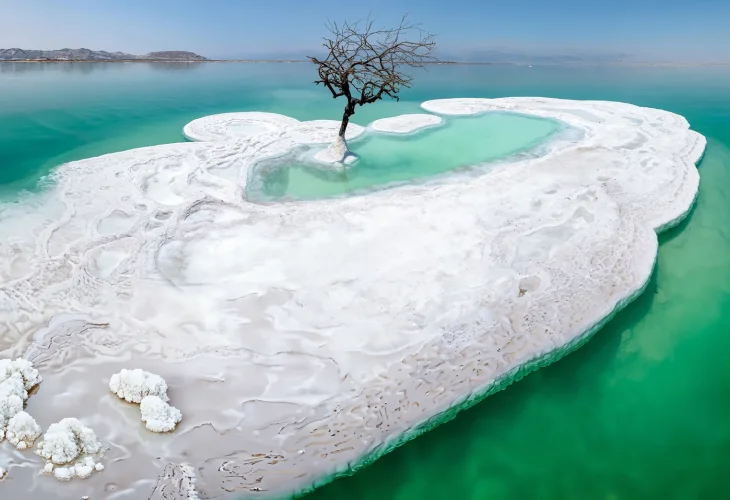Unearthing Sodom: A Story Buried in Ash
This city was obliterated. A meter-thick layer of ash blankets it, yet it wasn’t fire or human hands—it was an explosion.
 Dead Sea (Photo: Shutterstock)
Dead Sea (Photo: Shutterstock)Despite the miraculous rescue of the people of Sodom by Abraham, their ways did not improve. On the contrary, they became even more wicked, feeling free and liberated from the yoke of the four kings. Hashem decreed their destruction through a catastrophe. The tale of Sodom's destruction echoes through generations: even Moses uses it in the curses in Parshat Nitzavim: "Sulfur and salt, all its land shall burn; it is not sown, and it does not sprout, and no grass grows there, like the overturning of Sodom and Gomorrah, Admah and Zeboiim, which Hashem overturned in His anger and wrath."
The prophet Amos says: "I have overthrown you, as Hashem overthrew Sodom and Gomorrah, and you are like a smoking ember snatched from the fire; yet you did not return to Me, says Hashem"; and Isaiah: "Had Hashem, the Lord of Hosts, not left us a remnant, we would have been like Sodom, we would have resembled Gomorrah: Hear the word of Hashem, leaders of Sodom; listen to the Torah of our God, people of Gomorrah."
But it wasn’t only in Israel that Sodom's destruction was remembered. In the archives of the ancient city of Ebla in Syria, a list of the five cities of the plain appears, "Sodom and Gomorrah, Admah and Zeboiim, and Zoar", in the exact order as in the Torah, and the name "Bera" is also mentioned as the king of Admah.
When and where did the destruction of Sodom occur?
Remains of ancient cities in the Dead Sea area were discovered as early as the 19th century. In the "Bab edh-Dhra" region, an enormous cemetery with tens of thousands of tombs was found. Some identified this as Sodom and her daughters. However, Bab edh-Dhra is located south of the Dead Sea, whereas Sodom is described as north of the Dead Sea, the Jordan plain—a lush oasis nourished by fresh waters.
Archaeologist Professor Steven Collins conducted excavations in the area of Bethel. In 2002, the second Intifada broke out, and the police ordered him to pack up and leave. Collins stood on the mountain ridge, gazing over the cities of the plain. He recalled that Abraham stood in this same position nearly 4000 years ago, parting from Lot, and later on after Sodom’s destruction, viewing the smoke rising to the sky. But how could cities south of the Dead Sea tongue be seen from Israel's mountain ridge? Collins was determined to find the true location of Sodom and her daughters, as described in the Bible, near the Jordan River's mouth.
There, he needed the cooperation of the gracious Jordanians, who, after international pressure, permitted Collins to dig at Tall el-Hammam. Tall el-Hammam was a very large and fortified city, fitting the description of Sodom as a city with a gate (Genesis 19). The city spanned over 600 dunams.
This city was destroyed. It is covered in a meter-thick layer of ash, but it was not fire or human hands—it was an explosion. How do they know? Because the explosion created a temperature exceeding 8000 degrees. Sand turned to glass. A glazing layer contains components indicating the intensity of the heat, the blast wave, and the speed at which the event occurred—it all took seconds. An area of 500 square kilometers north of the Dead Sea was left desolate for 600 years due to soil erosion and coverage by hot salt fallout that rose from the Dead Sea.
Refer again to Deuteronomy: "Sulfur and salt burning its entire land; not sown, nor does it sprout, nor does grass grow in it, like the overturning of Sodom and Gomorrah, Admah and Zeboiim, which Hashem overturned in His anger and wrath."
Such an event could only occur due to a nuclear explosion or a meteor strike (Collins argued that Sodom's destruction was by a meteor, explaining why the fugitives were forbidden to look back, as the light flash would blind someone, preventing further ascent on the mountain. Lot's wife looked back, was blinded and fell, thus becoming a part of the revolution, turning into a pillar of salt). The dawn after the destruction—"And he gazed toward Sodom and Gomorrah, and at all the land of the plain; he saw, and behold, the smoke of the land was going up like the smoke of a furnace"—reflects an eyewitness angle. This is what the event would have looked like from the mountain top, for anyone observing it.
When did the event happen? According to carbon-14 tests, around 1700 BCE, with an error range of fifty years, meaning the earliest is 1750 BCE and the latest is 1650 BCE.
If we take the earliest date, it coincides with the closing window of opportunity of the war of the four kings (as mentioned in earlier chapters, at some point, there were no more coalitions of kings in Mesopotamia), 1750 BCE. If the Exodus was four hundred years after the covenant between the pieces (an event that the author of Seder Olam describes with Abraham at age 70), then it occurred in 1320 BCE. This matches the traditional dating as found in the "Seder Olam" by Rabbi Yossi ben Halafta.
Tall el-Hammam stood for hundreds of years, a monument through generations illustrating the end of the wicked.

